Dye Dale, O`neill Robert. The road to victory: From Pearl Harbor to Okinawa
Подождите немного. Документ загружается.

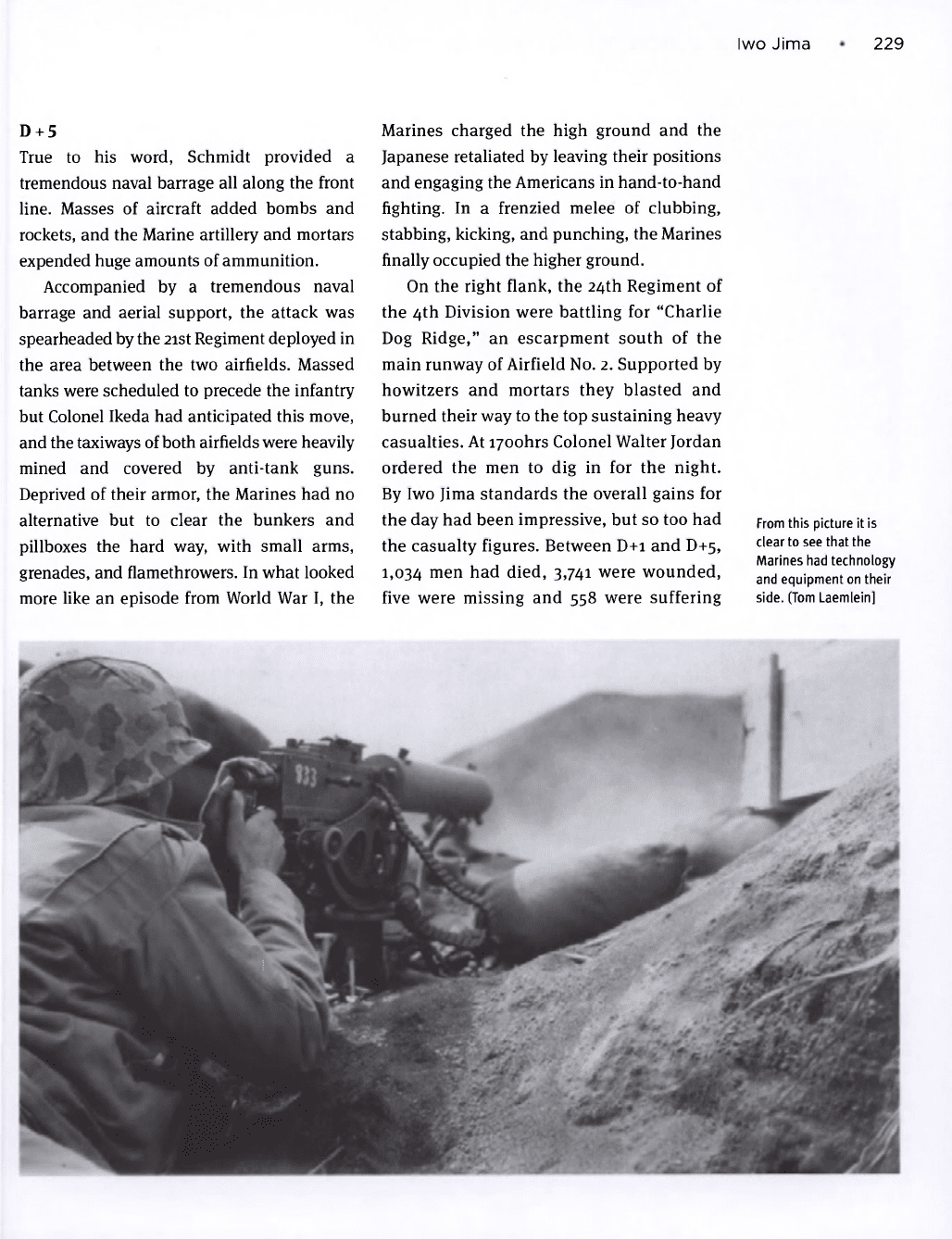
Iwo Jima • 229
D
+
5
True to his word, Schmidt provided a
tremendous naval barrage all along the front
line. Masses of aircraft added bombs and
rockets, and the Marine artillery and mortars
expended huge amounts of ammunition.
Accompanied by a tremendous naval
barrage and aerial support, the attack was
spearheaded by the 21st Regiment deployed in
the area between the two airfields. Massed
tanks were scheduled to precede the infantry
but Colonel Ikeda had anticipated this move,
and the taxiways of both airfields were heavily
mined and covered by anti-tank guns.
Deprived of their armor, the Marines had no
alternative but to clear the bunkers and
pillboxes the hard way, with small arms,
grenades, and flamethrowers. In what looked
more like an episode from World War I, the
Marines charged the high ground and the
Japanese retaliated by leaving their positions
and engaging the Americans in hand-to-hand
fighting. In a frenzied melee of clubbing,
stabbing, kicking, and punching, the Marines
finally occupied the higher ground.
On the right flank, the 24th Regiment of
the 4th Division were battling for "Charlie
Dog Ridge," an escarpment south of the
main runway of Airfield No. 2. Supported by
howitzers and mortars they blasted and
burned their way to the top sustaining heavy
casualties. At i700hrs Colonel Walter Jordan
ordered the men to dig in for the night.
By Iwo Jima standards the overall gains for
the day had been impressive, but so too had
the casualty figures. Between D+i and D+5,
1,034
men
had died, 3,741 were wounded,
five were missing and 558 were suffering
From this picture it is
clear to see that the
Marines had technology
and equipment on their
side. (Tom Laemlein]
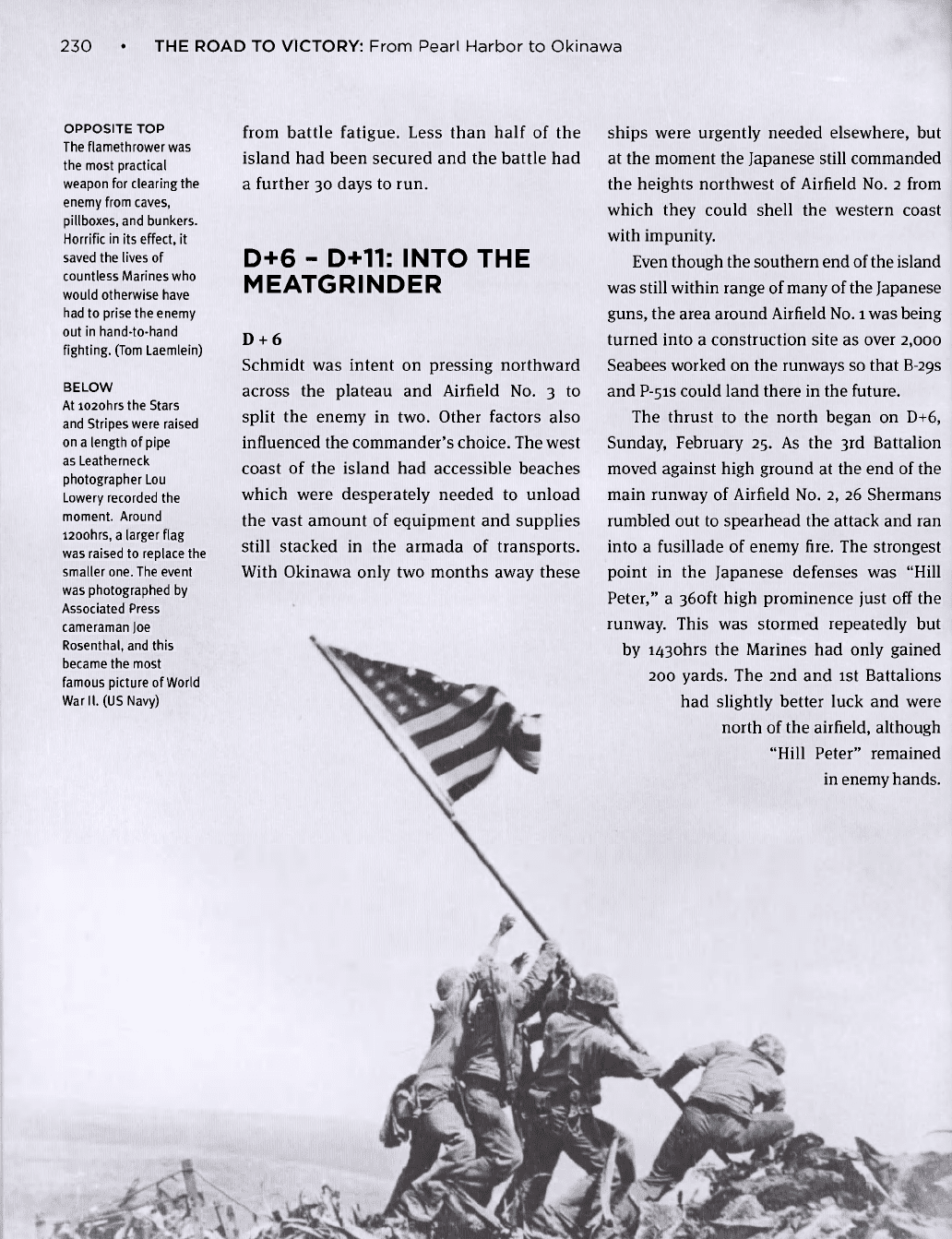
230 • THE ROAD TO VICTORY: From Pearl Harbor to Okinawa
ships were urgently needed elsewhere, but
at the moment the Japanese still commanded
the heights northwest of Airfield No. 2 from
which they could shell the western coast
with impunity.
Even though the southern end of the island
was still within range of many of the Japanese
guns, the area around Airfield No. 1 was being
turned into a construction site as over 2,000
Seabees worked on the runways so that B-29S
and P-51S could land there in the future.
The thrust to the north began on D+6,
Sunday, February 25. As the 3rd Battalion
moved against high ground at the end of the
main runway of Airfield No. 2, 26 Shermans
rumbled out to spearhead the attack and ran
into a fusillade of enemy fire. The strongest
point in the Japanese defenses was "Hill
Peter," a 360ft high prominence just off the
runway. This was stormed repeatedly but
by i43ohrs the Marines had only gained
200 yards. The 2nd and 1st Battalions
had slightly better luck and were
north of the airfield, although
"Hill Peter" remained
in enemy hands.
OPPOSITE TOP
The flamethrower was
the most practical
weapon for clearing the
enemy from caves,
pillboxes, and bunkers.
Horrific in its effect, it
saved the lives of
countless Marines who
would otherwise have
had to prise the enemy
out in hand-to-hand
fighting. (Tom Laemlein)
BELOW
At io2ohrsthe Stars
and Stripes were raised
on a length of pipe
as Leatherneck
photographer Lou
Lowery recorded the
moment. Around
i200hrs, a larger flag
was raised to replace the
smaller one. The event
was photographed by
Associated Press
cameraman ]oe
Rosenthal, and this
became the most
famous picture of World
Warll. (US Navy)
from battle fatigue. Less than half of the
island had been secured and the battle had
a further 30 days to run.
D+6 - D+11: INTO THE
MEATGRINDER
D
+
6
Schmidt was intent on pressing northward
across the plateau and Airfield No. 3 to
split the enemy in two. Other factors also
influenced the commander's choice. The west
coast of the island had accessible beaches
which were desperately needed to unload
the vast amount of equipment and supplies
still stacked in the armada of transports.
With Okinawa only two months away these
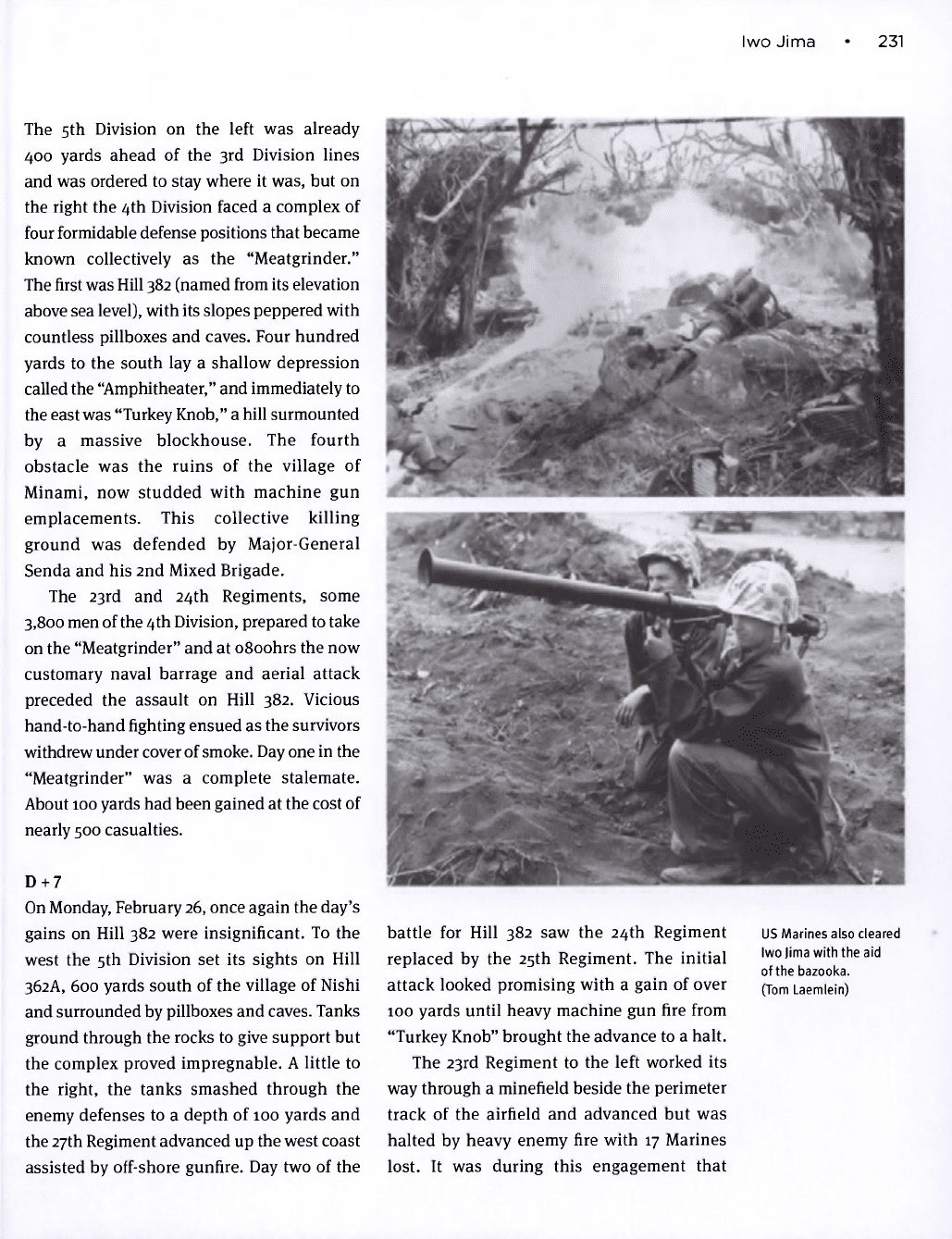
Iwo Jima • 231
The 5th Division on the left was already
400 yards ahead of the 3rd Division lines
and was ordered to stay where it was, but on
the right the 4th Division faced a complex of
four formidable defense positions that became
known collectively as the "Meatgrinder."
The first was Hill 382 (named from its elevation
above sea level), with its slopes peppered with
countless pillboxes and caves. Four hundred
yards to the south lay a shallow depression
called the "Amphitheater," and immediately to
the east was "Turkey Knob," a hill surmounted
by a massive blockhouse. The fourth
obstacle was the ruins of the village of
Minami, now studded with machine gun
emplacements. This collective killing
ground was defended by Major-General
Senda and his 2nd Mixed Brigade.
The 23rd and 24th Regiments, some
3,800 men of the 4th Division, prepared to take
on the "Meatgrinder" and at o8oohrs the now
customary naval barrage and aerial attack
preceded the assault on Hill 382. Vicious
hand-to-hand fighting ensued as the survivors
withdrew under cover of smoke. Day one in the
"Meatgrinder" was a complete stalemate.
About 100 yards had been gained at the cost of
nearly 500 casualties.
D+7
On Monday, February 26, once again the day's
gains on Hill 382 were insignificant. To the
west the 5th Division set its sights on Hill
362A, 600 yards south of the village of Nishi
and surrounded by pillboxes and caves. Tanks
ground through the rocks to give support but
the complex proved impregnable. A little to
the right, the tanks smashed through the
enemy defenses to a depth of 100 yards and
the 27th Regiment advanced up the west coast
assisted by off-shore gunfire. Day two of the
battle for Hill 382 saw the 24th Regiment
replaced by the 25th Regiment. The initial
attack looked promising with a gain of over
100 yards until heavy machine gun fire from
"Turkey Knob" brought the advance to a halt.
The 23rd Regiment to the left worked its
way through a minefield beside the perimeter
track of the airfield and advanced but was
halted by heavy enemy fire with 17 Marines
lost. It was during this engagement that
US Marines also cleared
Iwo |ima with the aid
of the bazooka.
(Tom Laemlein)
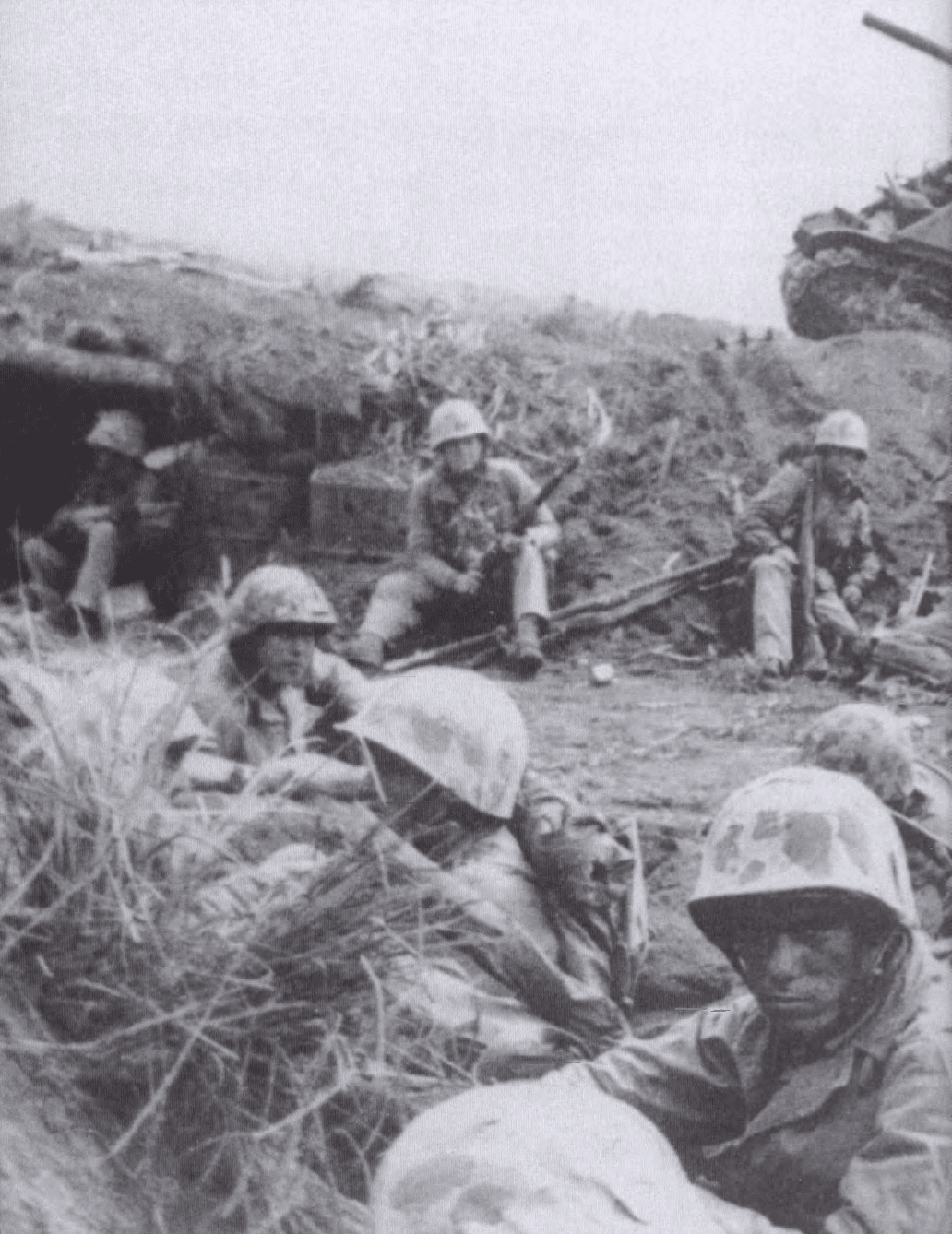
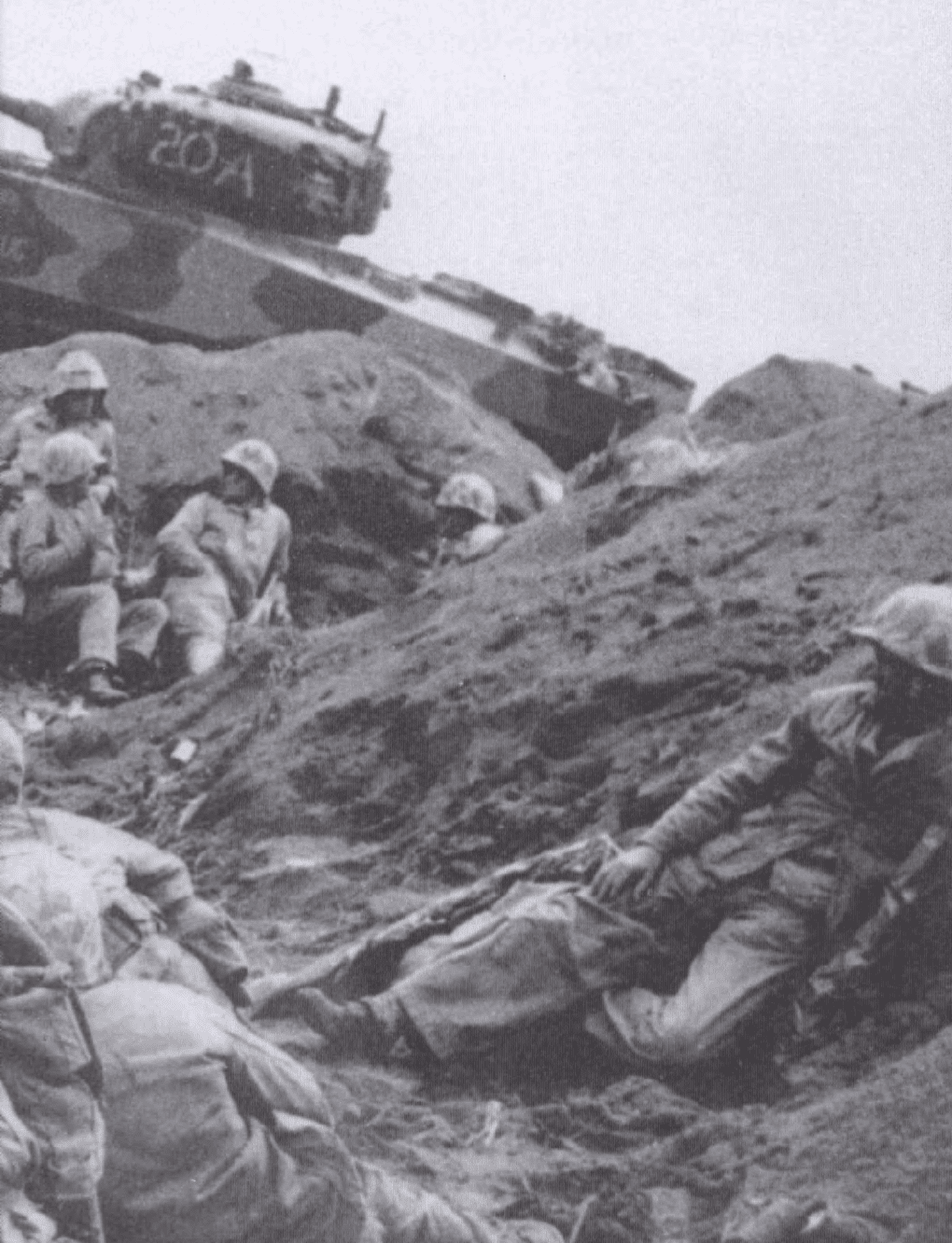
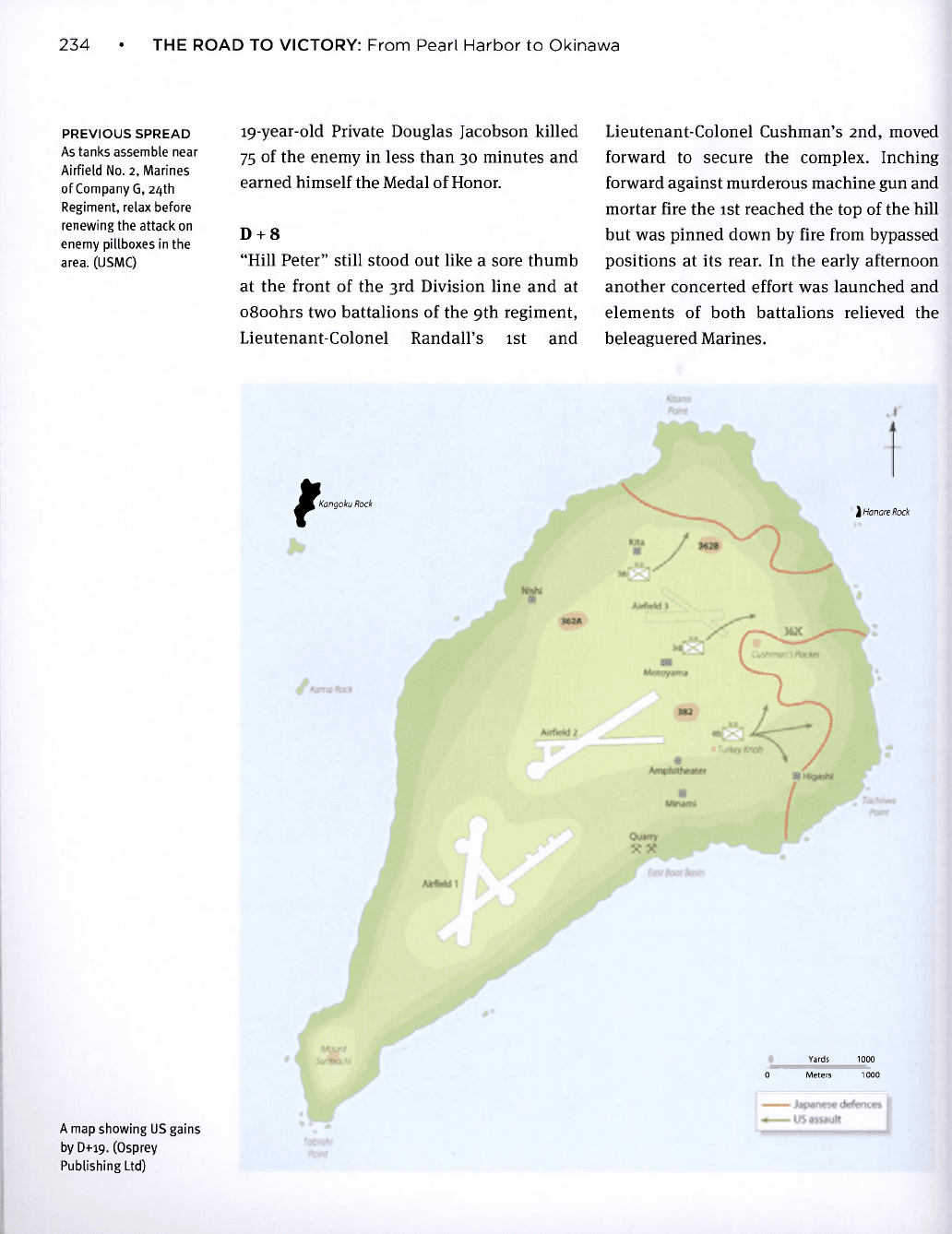
234 • THE ROAD TO VICTORY: From Pearl Harbor to Okinawa
PREVIOUS SPREAD
As tanks assemble near
Airfield No. 2, Marines
of Company G, 24th
Regiment, relax before
renewing the attack on
enemy pillboxes in the
area. (USMC)
19-year-old Private Douglas Jacobson killed
75 of the enemy in less than 30 minutes and
earned himself the Medal of Honor.
D
+
8
"Hill Peter" still stood out like a sore thumb
at the front of the 3rd Division line and at
o8oohrs two battalions of the 9th regiment,
Lieutenant-Colonel Randall's 1st and
Lieutenant-Colonel Cushman's 2nd, moved
forward to secure the complex. Inching
forward against murderous machine gun and
mortar fire the 1st reached the top of the hill
but was pinned down by fire from bypassed
positions at its rear. In the early afternoon
another concerted effort was launched and
elements of both battalions relieved the
beleaguered Marines.
A map showing US gains
by D+19. (Osprey
Publishing Ltd)
t
Kangoku Rock
| Hanare Rock
Yards 1000
0 Meters 1000
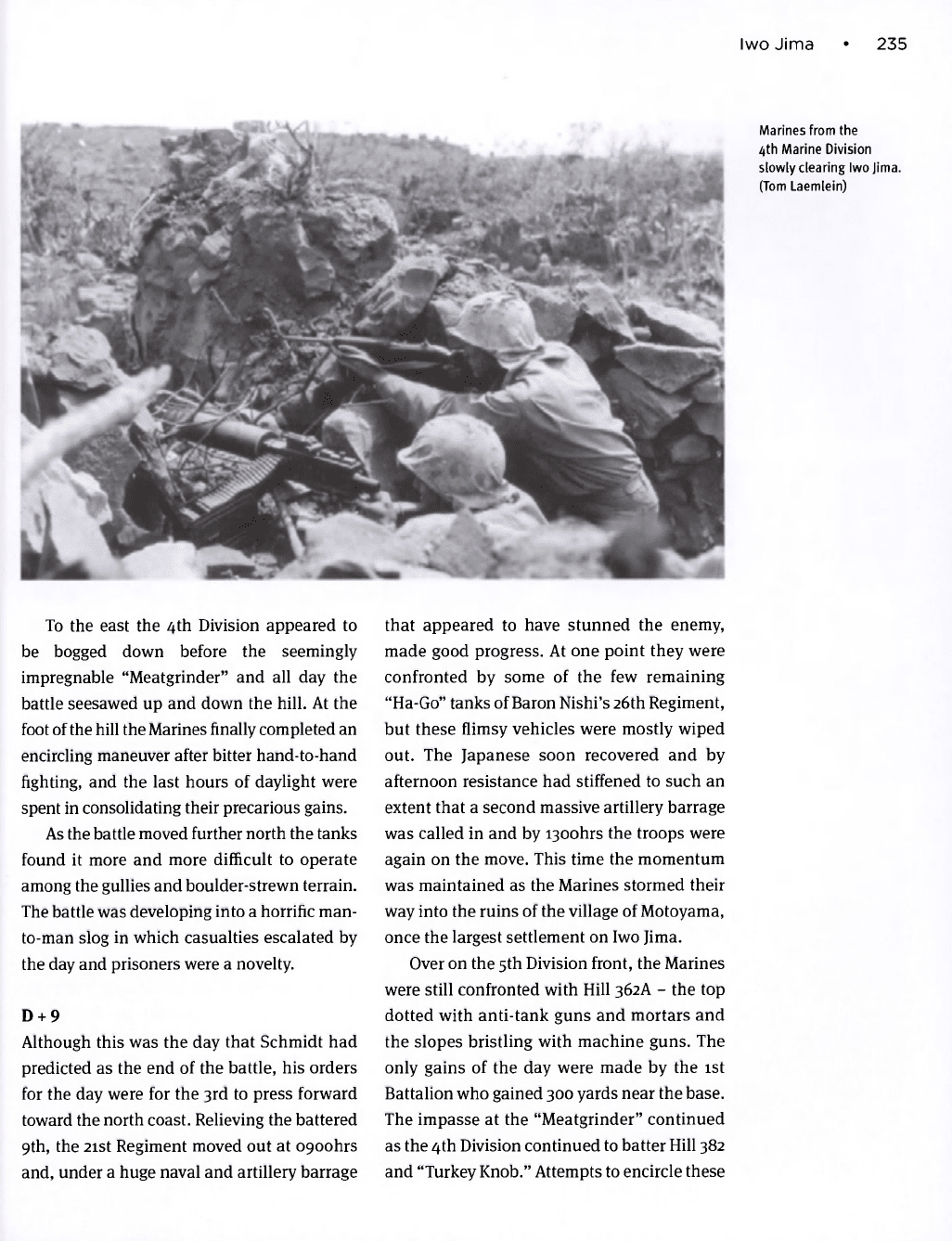
Iwo Jima • 235
Marines from the
4th Marine Division
slowly clearing Iwo Jima.
(Tom Laemlein)
To the east the 4th Division appeared to
be bogged down before the seemingly
impregnable "Meatgrinder" and all day the
battle seesawed up and down the hill. At the
foot of the hill the Marines finally completed an
encircling maneuver after bitter hand-to-hand
fighting, and the last hours of daylight were
spent in consolidating their precarious gains.
As the battle moved further north the tanks
found it more and more difficult to operate
among the gullies and boulder-strewn terrain.
The battle was developing into a horrific man-
to-man slog in which casualties escalated by
the day and prisoners were a novelty.
D
+
9
Although this was the day that Schmidt had
predicted as the end of the battle, his orders
for the day were for the 3rd to press forward
toward the north coast. Relieving the battered
9th, the 21st Regiment moved out at ogoohrs
and, under a huge naval and artillery barrage
that appeared to have stunned the enemy,
made good progress. At one point they were
confronted by some of the few remaining
"Ha-Go" tanks of Baron Nishi's 26th Regiment,
but these flimsy vehicles were mostly wiped
out. The Japanese soon recovered and by
afternoon resistance had stiffened to such an
extent that a second massive artillery barrage
was called in and by i300hrs the troops were
again on the move. This time the momentum
was maintained as the Marines stormed their
way into the ruins of the village of Motoyama,
once the largest settlement on Iwo Jima.
Over on the 5th Division front, the Marines
were still confronted with Hill 362A - the top
dotted with anti-tank guns and mortars and
the slopes bristling with machine guns. The
only gains of the day were made by the 1st
Battalion who gained 300 yards near the base.
The impasse at the "Meatgrinder" continued
as the 4th Division continued to batter Hill 382
and "Turkey Knob." Attempts to encircle these
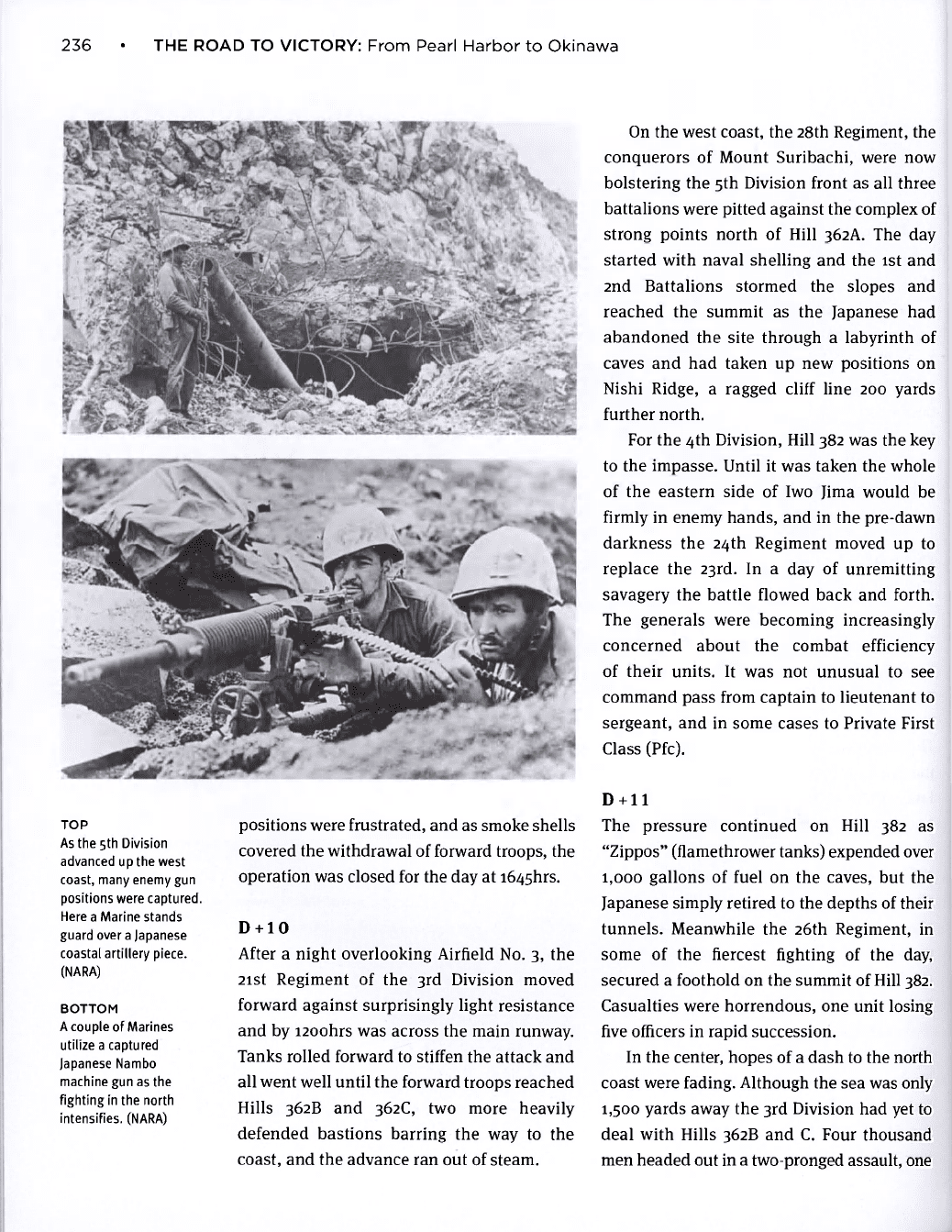
236 • THE ROAD TO VICTORY: From Pearl Harbor to Okinawa
TOP
As the 5th Division
advanced up the west
coast, many enemy gun
positions were captured.
Here a Marine stands
guard over a Japanese
coastal artillery piece.
(NARA)
BOTTOM
A couple of Marines
utilize a captured
Japanese Nambo
machine gun as the
fighting in the north
intensifies. (NARA)
positions were frustrated, and as smoke shells
covered the withdrawal of forward troops, the
operation was closed for the day at i645hrs.
D+10
After a night overlooking Airfield No. 3, the
21st Regiment of the 3rd Division moved
forward against surprisingly light resistance
and by i2oohrs was across the main runway.
Tanks rolled forward to stiffen the attack and
all went well until the forward troops reached
Hills 362B and 362C, two more heavily
defended bastions barring the way to the
coast, and the advance ran out of steam.
On the west coast, the 28th Regiment, the
conquerors of Mount Suribachi, were now
bolstering the 5th Division front as all three
battalions were pitted against the complex of
strong points north of Hill 362A. The day
started with naval shelling and the 1st and
2nd Battalions stormed the slopes and
reached the summit as the Japanese had
abandoned the site through a labyrinth of
caves and had taken up new positions on
Nishi Ridge, a ragged cliff line 200 yards
further north.
For the 4th Division, Hill 382 was the key
to the impasse. Until it was taken the whole
of the eastern side of Iwo Jima would be
firmly in enemy hands, and in the pre-dawn
darkness the 24th Regiment moved up to
replace the 23rd. In a day of unremitting
savagery the battle flowed back and forth.
The generals were becoming increasingly
concerned about the combat efficiency
of their units. It was not unusual to see
command pass from captain to lieutenant to
sergeant, and in some cases to Private First
Class (Pfc).
D
+
ll
The pressure continued on Hill 382 as
"Zippos" (flamethrower tanks) expended over
1,000 gallons of fuel on the caves, but the
Japanese simply retired to the depths of their
tunnels. Meanwhile the 26th Regiment, in
some of the fiercest fighting of the day,
secured a foothold on the summit of Hill 382.
Casualties were horrendous, one unit losing
five officers in rapid succession.
In the center, hopes of a dash to the north
coast were fading. Although the sea was only
1,500 yards away the 3rd Division had yet to
deal with Hills 362B and C. Four thousand
men headed out in a two-pronged assault, one
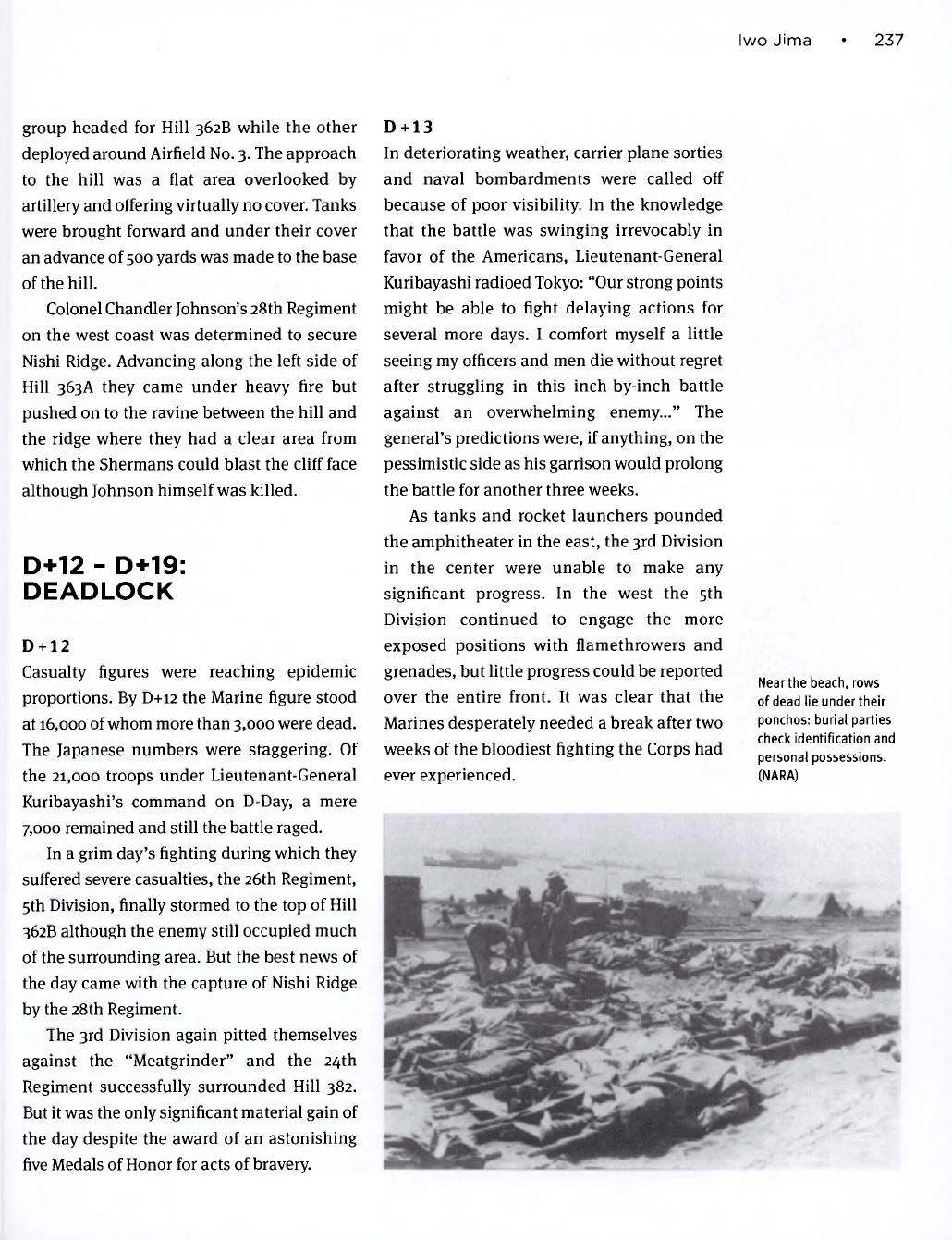
Iwo Jima • 237
group headed for Hill 362B while the other
deployed around Airfield No. 3. The approach
to the hill was a flat area overlooked by
artillery and offering virtually no cover. Tanks
were brought forward and under their cover
an advance of 500 yards was made to the base
of the hill.
Colonel Chandler Johnson's 28th Regiment
on the west coast was determined to secure
Nishi Ridge. Advancing along the left side of
Hill 363A they came under heavy fire but
pushed on to the ravine between the hill and
the ridge where they had a clear area from
which the Shermans could blast the cliff face
although Johnson himself was killed.
D+12 - D+19:
DEADLOCK
D+12
Casualty figures were reaching epidemic
proportions. By D+12 the Marine figure stood
at 16,000 of whom more than 3,000 were dead.
The Japanese numbers were staggering. Of
the 21,000 troops under Lieutenant-General
Kuribayashi's command on D-Day, a mere
7,000 remained and still the battle raged.
In a grim day's fighting during which they
suffered severe casualties, the 26th Regiment,
5th Division, finally stormed to the top of Hill
362B although the enemy still occupied much
of the surrounding area. But the best news of
the day came with the capture of Nishi Ridge
by the 28th Regiment.
The 3rd Division again pitted themselves
against the "Meatgrinder" and the 24th
Regiment successfully surrounded Hill 382.
But it was the only significant material gain of
the day despite the award of an astonishing
five Medals of Honor for acts of bravery.
D+13
In deteriorating weather, carrier plane sorties
and naval bombardments were called off
because of poor visibility. In the knowledge
that the battle was swinging irrevocably in
favor of the Americans, Lieutenant-General
Kuribayashi radioed Tokyo: "Our strong points
might be able to fight delaying actions for
several more days. I comfort myself a little
seeing my officers and men die without regret
after struggling in this inch-by-inch battle
against an overwhelming enemy..." The
general's predictions were, if anything, on the
pessimistic side as his garrison would prolong
the battle for another three weeks.
As tanks and rocket launchers pounded
the amphitheater in the east, the 3rd Division
in the center were unable to make any
significant progress. In the west the 5th
Division continued to engage the more
exposed positions with flamethrowers and
grenades, but little progress could be reported
over the entire front. It was clear that the
Marines desperately needed a break after two
weeks of the bloodiest fighting the Corps had
ever experienced.
Near the beach, rows
of dead lie under their
ponchos: burial parties
check identification and
personal possessions.
(NARA)
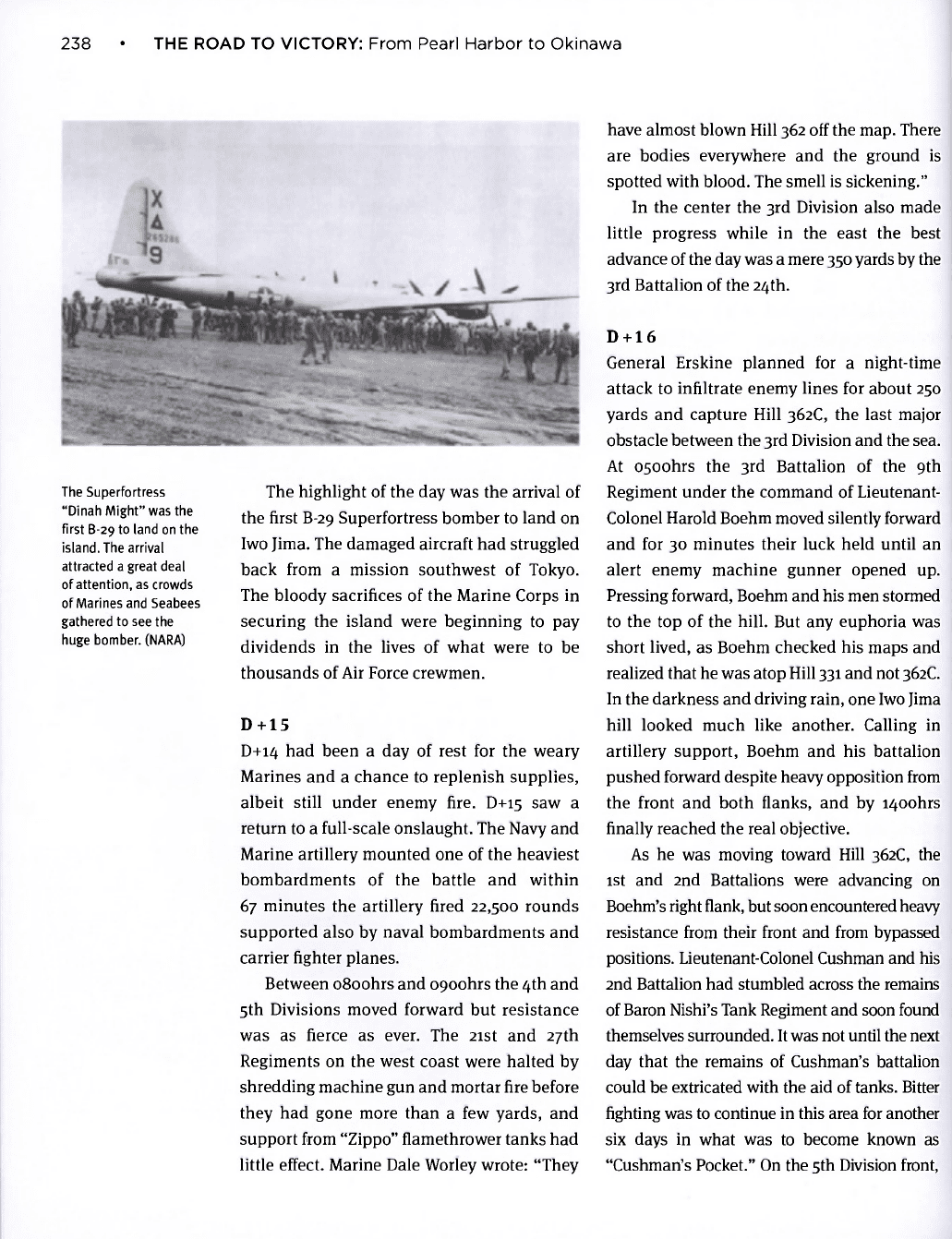
238 • THE ROAD TO VICTORY: From Pearl Harbor to Okinawa
The Superfortress
"Dinah Might" was the
first B-29 to land on the
island. The arrival
attracted a great deal
of attention, as crowds
of Marines and Seabees
gathered to see the
huge bomber. (NARA)
The highlight of the day was the arrival of
the first B-29 Superfortress bomber to land on
Iwo Jima. The damaged aircraft had struggled
back from a mission southwest of Tokyo.
The bloody sacrifices of the Marine Corps in
securing the island were beginning to pay
dividends in the lives of what were to be
thousands of Air Force crewmen.
D +15
D+14 had been a day of rest for the weary
Marines and a chance to replenish supplies,
albeit still under enemy fire. D+15 saw a
return to a full-scale onslaught. The Navy and
Marine artillery mounted one of the heaviest
bombardments of the battle and within
67 minutes the artillery fired 22,500 rounds
supported also by naval bombardments and
carrier fighter planes.
Between o8oohrs and 0900hrs the 4th and
5th Divisions moved forward but resistance
was as fierce as ever. The 21st and 27th
Regiments on the west coast were halted by
shredding machine gun and mortar fire before
they had gone more than a few yards, and
support from "Zippo" flamethrower tanks had
little effect. Marine Dale Worley wrote: "They
have almost blown Hill 362 off the map. There
are bodies everywhere and the ground is
spotted with blood. The smell is sickening."
In the center the 3rd Division also made
little progress while in the east the best
advance of the day was a mere 350 yards by the
3rd Battalion of the 24th.
D
+
16
General Erskine planned for a night-time
attack to infiltrate enemy lines for about 250
yards and capture Hill 362C, the last major
obstacle between the 3rd Division and the sea.
At osoohrs the 3rd Battalion of the 9th
Regiment under the command of Lieutenant-
Colonel Harold Boehm moved silently forward
and for 30 minutes their luck held until an
alert enemy machine gunner opened up.
Pressing forward, Boehm and his men stormed
to the top of the hill. But any euphoria was
short lived, as Boehm checked his maps and
realized that he was atop Hill 331 and not 362C.
In the darkness and driving rain, one Iwo Jima
hill looked much like another. Calling in
artillery support, Boehm and his battalion
pushed forward despite heavy opposition from
the front and both flanks, and by i400hrs
finally reached the real objective.
As he was moving toward Hill 362C, the
1st and 2nd Battalions were advancing on
Boehm's right
flank,
but soon encountered heavy
resistance from their front and from bypassed
positions. Lieutenant-Colonel Cushman and his
2nd Battalion had stumbled across the remains
of Baron Nishi's Tank Regiment and soon found
themselves surrounded. It was not until the next
day that the remains of Cushman's battalion
could be extricated with the aid of tanks. Bitter
fighting was to continue in this area for another
six days in what was to become known as
"Cushman's Pocket." On the 5th Division front,
